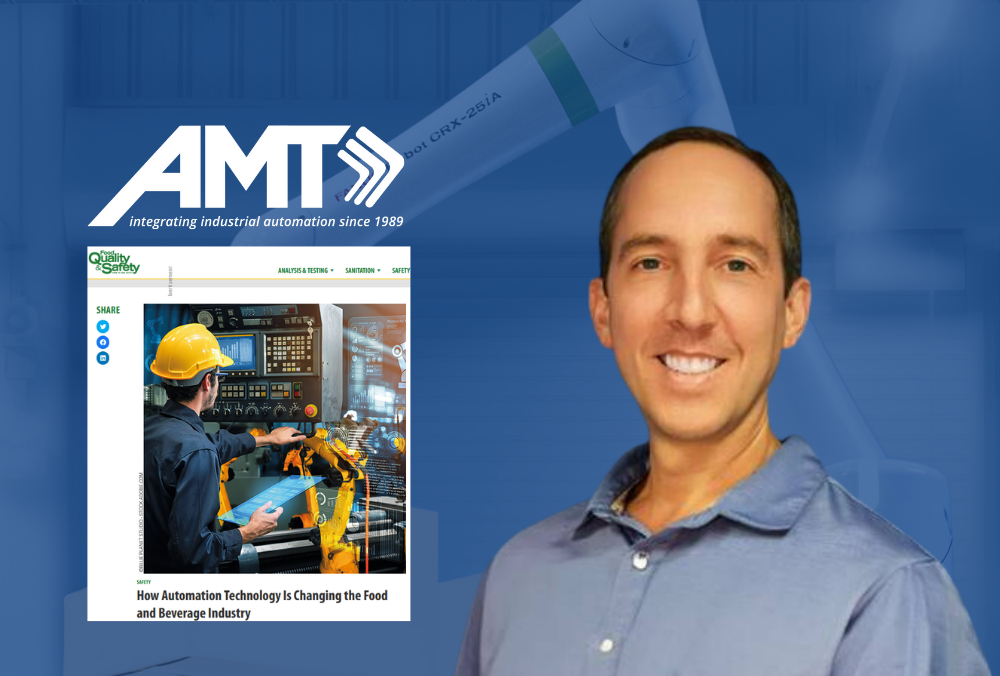Craig Salvalaggio Addresses Automation in Food Quality & Safety
Craig Salvalaggio was recently interviewed for a Food Quality & Safety article entitled “How Automation Technology is Changing the Food and Beverage Industry” by Andrea Tolu.
Read the original article here.
Applied Manufacturing Technologies has successfully completed a variety of types of projects in the food and beverage industry and COO Craig Salvalaggio was tapped by Food Quality & Safety writer Andrea Tolu to share industry insights.
Many manufacturing industries have quickly adopted Industry 4.0, but the food and beverage sector has been slow to incorporate digitalization into plants. “While in other sectors you can connect various devices together and collect data, in the food industry there is a lot of standalone equipment,” says Craig Salvalaggio. “It’s like having little islands connected by conveyors.”
He continues, “Before buying any [automation] equipment, companies should understand their current process, data, and metrics, and where they want to go from there—whether it’s increasing capacity, demand, or flexibility. You can learn a lot from visiting factories in other industries, such as automotive or aerospace.”
Rapid Evolution of Technology
The technology has evolved rapidly in the past several years, and there are many new solutions that can use automation to solve staffing shortages. “Robot end-of-arm tools for grasping can now pick fragile and irregular objects without damaging or marking them,” says Salvalaggio. “For example, we worked with a manufacturer to automate the process of putting pickles in jars. Using a combination of AI, grasping, and vision technology, we designed an application to identify the size and the structure of the pickles and select an optimal pick sequence. We demonstrated that we could get about 70% of the pickles into the jar reliably, with human intervention helping with the remaining 30%.”
Salvalaggio advises food and beverage manufacturers to take a data-driven approach to adding automation into their facilities and put a master plan in place before embarking on change. “Automation is a journey: You want to first crawl, then walk, and then run,” says Salvalaggio. “Before buying any equipment, companies should understand their current process, data, and metrics, and where they want to go from there, whether it’s increasing capacity, demand, or flexibility. You can learn a lot from visiting factories in other industries, such as automotive or aerospace.” To learn more about choosing a system integrator partner, read Craig Salvalaggio’s eBook.
Importance of a Master Plan
Salvalaggio cautions that without a master plan, much time and money could be wasted in purchasing equipment that isn’t necessarily compatible, as happened to a paper-industry manufacturer. “Where we see people getting into trouble is when they buy random machines from different vendors, only to find out they can’t support them in the long term because they use different processors and communication networks, or they behave differently from one another.”
Another consideration when adding automation is planning for the training of current and future personnel. Salvalaggio recommends clients implement three separate types of training when they adopt new automation: “maintenance training to ensure that people know how to do preventative maintenance and use the equipment; technical training for troubleshooting and debugging; and engineering, where you define what equipment goes into the plant, its specifications, safety requirements, etc.”
Salvalaggio predicts that technology will continue to evolve rapidly and meet many of the current challenges with automating non-standard products, such as in the food and beverage industry. “There will be more robotics, in particular Delta robots, which can handle objects with high speed and throughput rates. Also, we’re going to see a combination 3D sensing technology, along with AI algorithms that are specifically designed for handling distorted or unstructured products.”
For more information on AMT’s experience in the food and beverage industry, watch this video of an end-of-line robotic palletizing solution, watch this video for conveyance and robotic palletizing, and read this article on overcoming installation obstacles on a tight schedule.
Read the original article here.

